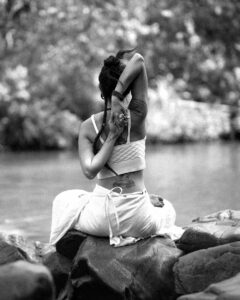 The 8 limbs of Yoga – Part 1: The 3. limb
The 8 limbs of Yoga – Part 1: The 3. limb
I often talk about the 8 limbs of Yoga and here is a bit of a breakdown what they are and in what context we can apply them to our lives.
‘Ashtanga Yoga’ literally means ‘8 limbs of Yoga’ from the Sanskrit ashta (8) and anga (limb) and features in the second book of Patanjali’s Yoga Sutras Sadhana Pada, written around 200 C.E.
There are many traditional discussions of the 8 limbs and what I try to do in my Yoga classes is to relate the ancient wisdom to modern day living. That way it is easier to apply the teachings of Yoga to our everyday lives and begin to live our Yoga off the mat as well as on the mat 😊.
Unlike what most people think when they start Yoga, the postures (asana) are only a small part of the 8 limbed path and are the 3rd limb (I often refer to it as the “Kindergarten” stage of Yoga).
So, before we ask the question, what comes before and what comes after asana, let’s take a closer look at the third limb (asana) and what it really means. Because, let’s face it, that’s why most of us started Yoga in the first place!
Asana literally means ‘to sit (as) with the breath (ana)’. That’s why the earliest depiction of Yoga postures are all seated postures, because the most important part about the posture was the awareness: to be still with the breath.
The body is an obvious place to start the practice of Yoga because it’s something that we can relate to. We see, use and feel it every day and everybody knows how frustrating and painful it can be when the body is not functioning as it should. Conversely, when the body is strong, healthy and limber, we tend to feel better about ourselves and life in general.
That’s why it makes sense to begin the Yoga practice with the body and from there, we are moving from the outside inwards, and the Yoga postures can be the start of this journey. Because when we move the body into new shapes (as for most of us the Yoga postures would be), the mind is equally challenged to explore new shapes, avenues, and perspectives as well. That means we are using our body directly to influence our thought processes. Add to that the focus on the breath, and you have a holistic practice that includes the toning of the muscular, skeletal, endocrine and nervous system – just through the Yoga postures!
What sets the practice of Yoga postures apart from other forms of exercise is that it’s not about the execution of the shape, i.e. the better the shape the better the result. Quite the opposite, the more you force yourself into a contorted shape, the less of a yogic result you get.
On the other hand, the more mindful, detached and calm you are in a posture the more it will positively add to the outer and inner effect of yoga. To get the therapeutic effect of the Yoga postures, you only need to approach the postures, and if you can do that equally with the body and with the mind (the imagination), you are pretty much there!
It’s a good reminder that the practice of yoga is about achieving calmness, practicing focus, uncovering a natural goodness and discovering a natural trait that in you has been covered up by too much thinking. It is not about going higher, further, better or deeper as a primary goal, that is a only a beneficial side effect.
“But”, you may ask, “why do we do postures that challenge us then? Couldn’t we just all flop on a bolster and be content that way?” Because to achieve the state of sattva (equanimity), we have to put the work into balancing the tamasic (lethargic) and the rajasic (hyperactive) states within us. By exploring difficult postures, we train the mind to be completely absorbed, while remaining calm and controlled in both breathing and focus. In the Yoga Sutras, Patanjali is very specific about the quality of the posture: It should have the qualities of both firmness (strength) and ease (flexibility), so to not interfere with the undivided focus of the mind.
The widespread tendency to practice the postures in such a way that they hurt or cause tightness or injury leads to a preoccupation of the body and is by definition not yoga, as it goes directly against the notion of ahimsa (non-harming).
However, in the beginning, admittedly, a lot of the postures feel difficult. And that’s precisely why we practice repetition of postures and sequences. We start to learn how to move our body and then after a while, we start to feel the posture from the inside. We notice how the quality of the breath and the complimentary opposites of activating and yielding give the posture an internal quality that we hadn’t experienced before. And that is when we start to go further in the practice, that’s when asana opens the door to the deeper layers of yoga.
Enjoy the journey!

